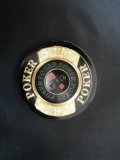Thanks for that info!
I wasn’t sure what made that glossy finish to it.
So the graphic inlay is a sticker below the laminate, and the laminate is melted/pressed into the chip to form a seamless bond to the chip?
The label is laminated, but it's not a sticker.
Envision a sheet of thin clear plastic that has adhesive on one side, applied to a sheet of paper or thin vinyl that contains dozens of round printed images. Once attached, the round shapes are punched out to create the inlays.
Take a separately made clay slug (with or without clay inserts, which will become the 'edge spots') and attach an inlay to each side (tiny dab of adhesive to keep it from moving), then place the slug into the lower mold cup and place the upper mold cup on top.
Add the necessary heat, pressure, and time needed for the machinery to soften the slug enough to take on the mold's unique characteristics and bond the inlays flush into the chip.
Once the pressed chip has cooled, grind or lathe the excess material on the rolling edge to the desired diameter.
That's how compression-molded chips are made.
The specific processes and procedures used vary by manufacturer (materials, time, pressure, heat, equipment, and capacity). Some processes press one or two slugs at a time, others may press up to 20 or more at once.


